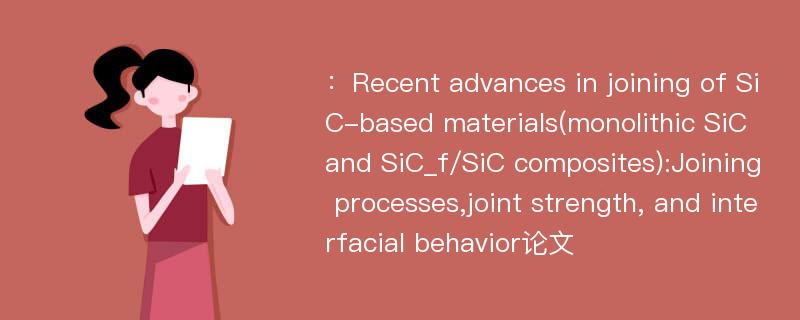
本文主要研究内容
作者(2019)在《Recent advances in joining of SiC-based materials(monolithic SiC and SiC_f/SiC composites):Joining processes,joint strength, and interfacial behavior》一文中研究指出:Silicon carbide(SiC) has been widely concerned for its excellent overall mechanical and physical properties, such as low density, good thermal-shock behavior, high temperature oxidation resistance, and radiation resistance; as a result, the SiC-based materials have been or are being widely used in most advanced fields involving aerospace, aviation, military, and nuclear power. Joining of SiC-based materials(monolithic SiC and SiCf/SiC composites) can resolve the problems on poor processing performance and difficulty of fabrication of large-sized and complex-shaped components to a certain extent, which are originated from their high inherent brittleness and low impact toughness.Starting from the introduction to SiC-based materials, joining of ceramics, and joint strength characterization, the joining of SiC-based materials is reviewed by classifying the as-received interlayer materials, involving no interlayer, metallic, glass-ceramic, and organic interlayers. In particular, joining processes(involving joining techniques and parameter conditions), joint strength,interfacial microstructures, and/or reaction products are highlighted for understanding interfacial behavior and for supporting development of application-oriented joining techniques.
Abstract
Silicon carbide(SiC) has been widely concerned for its excellent overall mechanical and physical properties, such as low density, good thermal-shock behavior, high temperature oxidation resistance, and radiation resistance; as a result, the SiC-based materials have been or are being widely used in most advanced fields involving aerospace, aviation, military, and nuclear power. Joining of SiC-based materials(monolithic SiC and SiCf/SiC composites) can resolve the problems on poor processing performance and difficulty of fabrication of large-sized and complex-shaped components to a certain extent, which are originated from their high inherent brittleness and low impact toughness.Starting from the introduction to SiC-based materials, joining of ceramics, and joint strength characterization, the joining of SiC-based materials is reviewed by classifying the as-received interlayer materials, involving no interlayer, metallic, glass-ceramic, and organic interlayers. In particular, joining processes(involving joining techniques and parameter conditions), joint strength,interfacial microstructures, and/or reaction products are highlighted for understanding interfacial behavior and for supporting development of application-oriented joining techniques.
论文参考文献
论文详细介绍
论文作者分别是来自Journal of Advanced Ceramics的,发表于刊物Journal of Advanced Ceramics2019年01期论文,是一篇关于,Journal of Advanced Ceramics2019年01期论文的文章。本文可供学术参考使用,各位学者可以免费参考阅读下载,文章观点不代表本站观点,资料来自Journal of Advanced Ceramics2019年01期论文网站,若本站收录的文献无意侵犯了您的著作版权,请联系我们删除。
